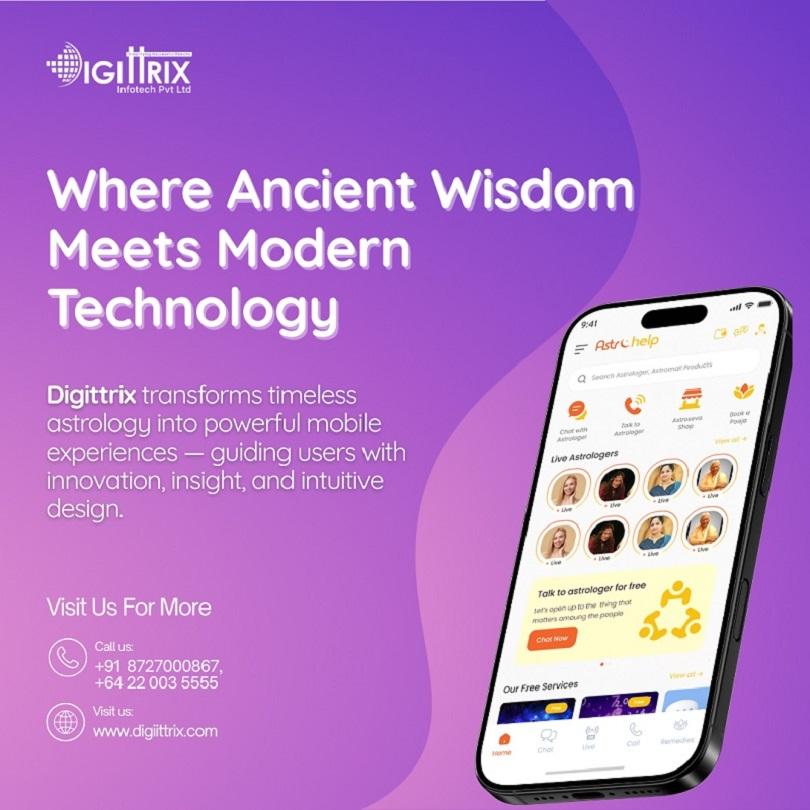Astrology apps are rapidly becoming one of the most downloaded lifestyle applications worldwide. In 2025, users expect these apps to offer accurate predictions, real-time planetary data, and personalized readings — all delivered instantly. The secret behind such seamless functionality lies in the right technology stack. Choosing the correct tools not only ensures precision but also boosts scalability and performance.
This article explores the tech stack behind the Building Astrology Apps: Strategy, Cost & Roadmap framework — explaining what technologies we use, why we use them, and how they contribute to a smooth astrology app experience.
Why the right tech stack matters
Building an astrology app isn’t just about creating beautiful interfaces; it’s about blending astronomical calculations with data visualization and real-time processing. The wrong stack can cause issues like lag, inaccurate readings, or slow response times.
Through expert astrology app development, developers can ensure the app remains stable while handling large datasets, celestial algorithms, and user personalization simultaneously. The right combination of tools sets the foundation for a reliable, fast, and scalable astrology platform.
Frontend development: Engaging and responsive
For the frontend, we prioritize frameworks like Flutter and React Native. These technologies allow for cross-platform development, ensuring both iOS and Android apps deliver consistent performance and design.
Why Flutter or React Native?
-
Faster development time with single codebase
-
Smooth animations and custom UI widgets
-
Real-time responsiveness for horoscope charts and predictions
-
Cost-effective deployment
The frontend also integrates chart visualization libraries like D3.js or Chart.js for rendering interactive birth charts and planetary movement animations.
Backend development: Powering real-time astrology logic
The backend forms the brain of the astrology app, managing calculations, data storage, and authentication. We use Node.js and Python (Django) for their flexibility, scalability, and speed.
Why Node.js and Python?
-
Node.js handles real-time data streaming, ideal for live predictions and updates.
-
Python supports accurate astrological algorithms and AI-based prediction engines.
-
Both technologies offer strong API integration capabilities with planetary data providers.
By combining these tools, astrology apps can deliver personalized horoscopes, compatibility scores, and live astrologer sessions without performance drops.
Database and storage solutions
To manage massive datasets like user profiles, birth chart data, and planetary ephemerides, we use MongoDB and PostgreSQL.
-
MongoDB is great for flexible data storage, ideal for dynamic astrology content.
-
PostgreSQL ensures data accuracy and handles transactional operations effectively.
This hybrid database approach guarantees performance stability and high query efficiency during heavy traffic hours, especially around lunar events or zodiac transitions.
Integrating APIs and AI models
Astrology apps rely heavily on APIs for planetary data, time zones, and astronomical positioning. We integrate third-party APIs that provide real-time ephemeris data and celestial calculations.
Additionally, AI and machine learning models help deliver predictive insights. These models analyze historical patterns to offer personalized readings and behavioral recommendations.
By integrating AI into the Building Astrology Apps: Strategy, Cost & Roadmap, developers can make astrological experiences more relevant and data-driven for each user.
Mobile optimization and performance tuning
Given that most users access astrology apps via mobile, performance optimization is crucial. Partnering with professionals in mobile app development ensures smooth performance across devices, even with heavy graphical elements.
This includes:
-
Caching data for offline access
-
Compressing planetary charts for quick loading
-
Implementing lazy loading for visual-heavy content
-
Enhancing energy efficiency to prevent battery drain
These optimizations create a balance between functionality and user satisfaction.
Cloud and security infrastructure
Security and uptime are non-negotiable in modern app ecosystems. We deploy apps on AWS and Google Cloud, ensuring global accessibility, scalability, and uptime of over 99%.
For user protection, we implement AES-256 encryption, OAuth 2.0 authentication, and GDPR-compliant storage. These measures keep sensitive user data — such as birth details and consultation logs — safe from breaches.
Final thoughts
Every successful astrology app begins with a clear tech vision. The Building Astrology Apps: Strategy, Cost & Roadmap approach ensures every technology used — from Flutter to AI — plays a defined role in enhancing user experience and system reliability.
By choosing a scalable, secure, and high-performing tech stack, developers can create astrology apps that combine spiritual wisdom with cutting-edge innovation — empowering users to connect with the cosmos effortlessly.

